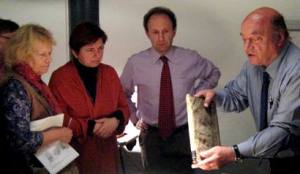Medieval manuscripts 2010: Bindings masterclass
The second Medieval Manuscripts Masterclass for 2010 was given on 1st November by Christopher Clarkson. Clarkson’s contributions to the field have been in his practical expertise; which has been in demand across the world from Florence in the 1960s to Slovenia and Egypt today, his inventions (of the foam book-rest system, phase-boxing and many other tools and props used in workshops, libraries and reading rooms every day), and of his work in education, constantly striving to develop and widen the knowledge and skills of all who work with books, at every stage of their careers.
The masterclass was in two parts: a talk on the development of bindings from the earliest forms of the codex to the beginning of paper text-blocks, followed by a display and explanation of some of the features he had described in the talk using manuscripts from the Bodleian’s collections.
The format of the seminar was particularly well-suited to the subject; complex aspects of binding technique can be very difficult to visualise even with diagrams and photographs, but explained with reference to an original example, such as the helical or ‘inside-out’ sewing of the 12th century MS. Laud Misc. 606, these concepts become much clearer.
Few examples of the earliest forms of the codex survive, and of those that do much of the crucial evidence has been destroyed. Nevertheless, by observation of details in representations of the book in illuminated manuscripts and other artistic forms, Clarkson was able to demonstrate a movement from the linked chain-stitch of the fourth-century codices, which open flat with a characteristic triangular shape at the spine when open, to the cord or band-supported sewing of manuscripts from the eighth-century onwards, which creates a curved leaf on opening. A frustrating gap in this theory is the example of the three great early codices Vaticanus (Vatican Library), Sinaiticus (split between several libraries, see the history here) and Alexandrinus (British Library), where the date of production would suggest a chain-stitch structure but the size and format of the leaves make this hard for a binder to imagine. Without clear binding evidence the original sewing structures of these manuscripts remains a mystery.
Clarkson then traced the development of different lacing patterns for the attachment of boards, and his examples included the remarkable MS. Bodl. 97 (Aldheld, De virginitate).

Bodleian Library, MS. Bodl. 97. Earlier Anglo-Saxon stitching shows on the fore-edge of the boards, after boards were turned and reused in a later rebinding.
This 11th century manuscript made in England was bound first with a typically Anglo-Saxon lacing pattern, and later re-bound using the same pair of boards turned 180 degrees, in a more typically Romanesque lacing path. Several other examples of lacing patterns were visible either where boards were partially exposed, or by using X-ray photographs, however neither of these methods can quite explain to modern conservators how the early craftsmen were able to drill such clean, accurate lacing tunnels in hard English oak!
Further illustrations of the development of style and function focussed on the covering of books, particularly the treatment of the excess covering material left at the spine when the other edges have been turned in.
We saw examples of sewn, brocaded and folded tabs protruding from the top and tail of the spine, and a lovely example of style over function in MS. Marshall 19, where a tab has been cut for visual effect even though the edges of the covering skin are cut flush with the manuscript and there was no excess material to warrant this. The use of extended over-covers, or chemises, as well as various fastening techniques and furniture were discussed, including the particularly skillful needlework of sewn corners and fitted ‘envelope pockets’ of the chemise covers.
The seminar ended with a brief discussion of the move from monastic to lay binding, with examples of very finely bound books being produced for monasteries such as the elaborately blind-stamped MS. Broxbourne 83.1 (Glossed gospel of St John, Paris) bound in the mid 12th century, and of the later longstitch bindings with parchment covers, produced for students and the lay market, such as the 15th century printed book Broxbourne 13.10. (Gerard van Zutphen, Devotus tracatulus de spiritualibus ascensionibus, c. 1486)
— Nicole Gilroy, Bodleian Conservation Section






Comments are closed.